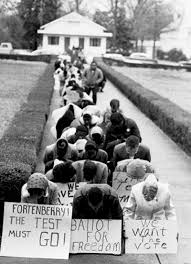The lecture in week 8: “‘Race,’ Inclusion and Exclusion-
Africans Americans,” caused a number of personal reflections as the events and
conflicts of the key years 1960 – 1968 were illuminated. My own UK based experiences
of the period were dominated by Black Culture. But it was the music and
personalities of the USA Tamla Motown, ‘Hitsville’ Music empire created by
Berry Gordy. I retrieved my copy of the original programme for the touring
Tamla show at the Hammersmith Palais in London. The Supremes are pictured in
their full glamour, as they are on numerous YouTube videos. I continued to muse
on the contrast between this show biz sparkle and the realities of the Civil
Rights Movement in 1960s America. Where could this highly successful enterprise
be situated in the assimilation / segregation debate?
The three singers met as children in the Brewster-Douglass
Housing Project in Detroit.
This was the first American federally funded
housing for African Americans. This was a ‘segregated’ neighbourhood but
welcomed by black families moving in from much poorer housing elsewhere. Significantly
the Brewster Homes were close to the black entertainment district known as Paradise
Valley. It was here that the Tamla Motown ‘sound’ was created by Berry Gordy
using the talent that ‘walked in off the streets’
 |
| Photo of Supremes in their former High School locker room |
The Civil Rights movement was the background context of the
lives of the young Supremes. The campaign’s employment of a variety of nonviolent
confrontation tactics took place in ordinary locations which would have
appeared as familiar territory to any teenager: kneel- ins at churches, sit-ins
at lunch counters and on parks, beaches, libraries,
theaters, museums, and other public places.
There was a “walk to freedom” in
Detroit in 1963.
On Palm Sunday 1964, at the Second Presbyterian Church in Memphis, Tennessee, a group of black and white students began a "kneel-in" to protest the church's policy of segregation-a protest that would continue in one form or another for more than a year and eventually force the church to open its doors to black worshippers. "Kneel-ins" were the strategy of choice for bringing attention to segregationist policies in Southern churches. These protests involved surprise visits to targeted churches, usually during Easter season, and often resulted in physical standoffs. The spectacle of kneeling worshippers barred from entering the church made for a powerful image, and invited both local and national media attention.
The situation intensified in USA at precisely the same time the Supremes were on their United Kingdom tour with the Motown Hitsville Show.
On Sunday, March 7 1965, Hosea Williams and John Lewis led a march of 525 pilgrims, who intended to walk the 54 miles from Selma to the state capital in Montgomery. Only six blocks into the march, however, at the Edmund Pettus Bridge on Jefferson Davis Highway, Alabama state troopers and local law enforcement officers attacked the peaceful demonstrators with billy clubs, tear gas, rubber tubes wrapped in barbed wire, and bull whips. The defenseless marchers were driven back into Selma. John Lewis was knocked unconscious and dragged to safety, while at least 16 other marchers were hospitalized.
Meanwhile, in
preparation for their scaling the heights of commercial success, the Supremes
undertook a special ‘Artist Development’ programme similar to
the Hollywood charm schools of the 30s and 40s. Maxine Powell gave lessons on
the proper way to dress, eat, sit, walk and how to appear on television.
The Supremes appeared at the Hammersmith Palais on March 21st 1965.
http://www.vam.ac.uk/content/articles/t/the-story-of-the-supremes-from-the-mary-wilson-collection/
The Supremes appeared at the Hammersmith Palais on March 21st 1965.
http://www.vam.ac.uk/content/articles/t/the-story-of-the-supremes-from-the-mary-wilson-collection/
Bibliography
http://www.motownmuseum.org/story/motown/
http://americanhistory.si.edu/blog/negro-motorists-green-book
http://www.blackpast.org/aah/negro-motorist-green-book-1936-1964



No comments:
Post a Comment